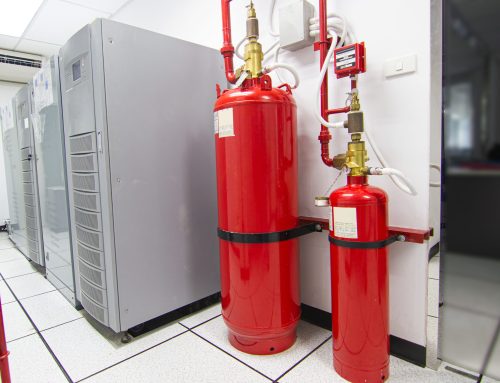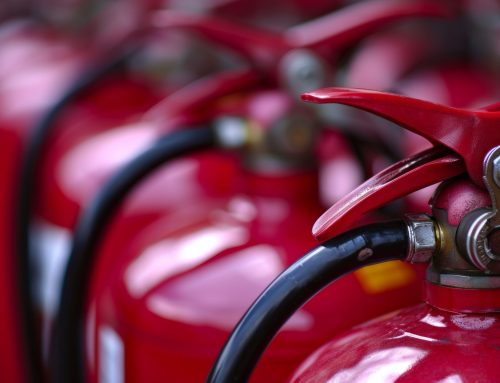Recreational vehicles, or RVs, are required by the NFPA to be equipped with at least one portable fire extinguisher. Though most RVs are equipped with multiple fire extinguishers, typically mounted at the entrance to any bedroom, in the kitchen area, and on the outside
Each extinguisher must be installed in accordance with NFPA 10 and located within 24 inches of the primary exit or means of escape. NFPA 1192 establishes life and safety criteria for recreational vehicles to provide protection from loss of life from fire and explosion. Within this standard the provisions for portable fire extinguishers are outlined.
Portable fire extinguishers save lives. RV fires are not an uncommon occurrence, so preparation and prevention are key.
How common are RV fires?
The U.S. Fire Administration reports the top causes for RV fires are unintentional actions and failure of equipment or heat source. Very rarely is the cause an act of nature. The leading areas of the origin in RV fires were found to be the engine area, running gear, and wheel area. Other areas of origin included the cooking area and passenger area of the vehicle.
Because there can be many different sources of ignition on an RV, the NFPA requires that all RVs must have a B:C rated fire extinguisher. Portable fire extinguishers are rated by classes. These classes tell you the type of fires the extinguisher can handle. For example, Class A includes ordinary combustibles like wood, paper, plastics, etc. Class B extinguishers are intended for flammable liquids and gasses, and Class C are to be used for fires involving live electrical equipment. The other two classes, Class D and Class K are used for metals or cooking fires involving oils. The reason that the NFPA requires a Class B:C extinguisher on RVs is because of the possibility of an engine fire, propane spill, or gas spill. These are flammable liquids that are commonly handled in and around an RV.
Preventing RV fires
In their “Complete Guide to RV Fire Extinguishers,” Let’s RV! suggests the following safety checklist before heading out on your next road trip:
- Ensure you have three working fire extinguishers in your RV (kitchen, bedroom, and on the outside in an unlocked compartment). Everybody traveling in your group must know how to properly operate an RV fire extinguisher, and which one to use on any particular fire.
- Immediately clean up any fuel spills. Gasoline and propane can combust quickly and soon get out of control. While diesel, although less flammable, will evaporate more slowly and pose a risk for longer.
- Look to see if there are any dirty or oily cloths lying around. Try using paper towels instead and get rid of them in the outside trash.
- Make sure all small batteries are kept secure in a plastic container so that they cannot roll or bounce around. Loose batteries that can move about can split or combine in a way that induces a fire.
- Your stove will continue to emit propane even with the flame extinguished. To avoid the risk of an explosion, double check that it is turned off properly when you’re finished and never heat your RV with the stove.
When should I replace my portable fire extinguisher?
Professional inspections are not required for portable fire extinguishers in RVs, but you should schedule your own visual inspection to be conducted on a regular basis. Look for signs of damage and check to see that the gauge is still set to green. If the extinguisher has been used for any reason, replace it.
Most hardware stores have a variety of portable fire extinguishers, and most RVs are equipped with mounts or pre-determined locations where an extinguisher should go. Be sure that your portable extinguisher(s) are not only in the right place, but also in full working order.
Know before you go
Before setting off on your next road trip, talk to all of your passengers about fire safety tips when travelling. Show everyone where the fire extinguishers are located and how and when to use them. You have to act fast in a fire emergency. If everyone travelling with you knows how to use a fire extinguisher, you’ll be prepared should a fire emergency occur.
A quick and easy way to remember the proper way to use a portable fire extinguisher is the acronym P.A.S.S. This stands for P- Pull the pin at the top of the extinguisher, A- aim the nozzle at the base of the fire, S- squeeze the handle, and S- sweep from side to side until the fire is out. Additionally, be sure to stand about 8 to 10 feet away from the fire. If the fire is not able to be controlled quickly, it’s time to evacuate the RV and call 911. Do not try to extinguish fires that are large or out of control.
Fire Systems, Inc.
As one of the leading fire protection company in the south east, Fire Systems has been serving the Atlanta area for over thirty years. We are an all-services fire protection company specializing in fire sprinkler systems, suppression, vehicle systems, fire alarm systems, and more. We are happy to answer all of your questions related to fire protection and life and safety systems. It’s our job and our honor to protect you and your business. There are few things more important than the safety of your employees. Fire Systems, Inc. can devise a detailed fire protection plan for your entire building. Call us today at 770-333-7979 for more information, or visit our website.






